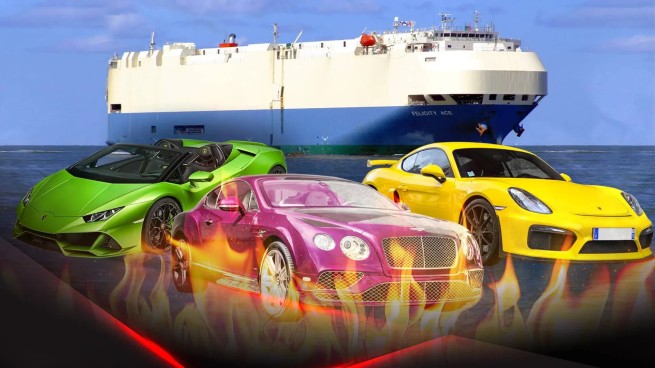The problem that arose among car owners who purchased electric cars on their own is taking on a wide scope. Limiting the number of these types of vehicles that can be carried on board a single vessel leaves drivers baffled.
The growing use of electric vehicles and the risk of their batteries catching fire when overcharged or overheated (cooling system problem) requires a reliable and realistic solution that needs to be found urgently.
International shipping is in turmoil over the problem of transporting electric and hybrid vehicles on ships (and of course, let's not forget that Greece has the most maritime transport in Europe).
Many Shipping companies refuse to transport electric cars after a series of incidents. In the summer of 2023, the Ro-Ro vessel Fremantle Highway burned down, as reported by Dutch media. According to updated data, the ship was delivering 3,783 cars, including 498 electric vehicles. The Fremantle Highway was heading from Germany to Egypt, but on July 25, a major fire broke out on the ship while passing through the North Sea. The fire raged on the ship for almost a week, but it was eventually extinguished. The crew was evacuated on July 26, with one person killed.

The most likely cause of the fire is spontaneous combustion of the battery of one of the electric vehicles. Emergency services in the Netherlands feared the Fremantle Highway would sink and cause an environmental disaster. Fortunately, everything worked out.
It's already This is not the first time that a ro-ro cruiser and thousands of cars on board have burned out due to an electric vehicle malfunction. At the beginning of 2022, the Felicity Ace ship with 4 thousand cars on board burned down in the Atlantic Ocean, then the fire started with one of the electric vehicles. He transported hundreds of luxury cars – Bentleys, Porsches and Lamborghinis – valued at more than $376 million.
The fire and sinking of the ship has brought to the forefront an important question: As the world quickly shifts to electric vehicles, how do we get them from factories to showrooms? And how will we “transfer” them to the islands?
The truth is that to this day no one knows the cause of the Felicity Ace fire. The answers lie 10,000 feet below the surface of the North Atlantic.
In general, fires on ships are a common occurrence. Over the past five years, about 70 such cases have been recorded. TOwhen it comes to electric vehicles, Maritime transport experts talk about a “new kind of risk.” Car transporters are designed taking into account fire extinguishing and fire protection measures, taking into account vehicles equipped with internal combustion engines.
Therefore, all these systems need to be redesigned, and you don’t need special knowledge to understand that a fire is extinguished in a battery and differently in cars with fuel tanks, and its expansion also has a different rate.

In such situations, decomposition of the active material in the battery may occur. A reaction begins between the anode and the electrolyte, thermal runaway through the mechanism of chain reactions, decomposition of battery components, ignition of the battery with a reactive flame and explosion. Its failure is accompanied by the release of toxic gases – methane, fluoride and hydrogen cyanide, which contribute to increased combustion. This also leads to poisoning of people in the car. The risk of fire is especially high when charging the battery and when it overheats in the hot season.
Extinguishing a battery fire is not so easy. This is due to its tightness: it can burn without access to oxygen. You also need a very large amount of high-pressure water to cool the ignited battery – about 10,000 liters.
There is a known case where it took firefighters 4 hours and more than 100,000 liters of water to extinguish an unmanned Tesla Model S. When extinguishing electric vehicles, there is also a danger of electric shock. If there is insufficient cooling, the battery may re-ignite. Most often, when it catches fire, the electric vehicle burns out completely.
To protect against fire, manufacturers install a temperature sensor and an electronic unit in each battery cell that monitors the condition of the cell. When the temperature rises, the electrical circuit is broken and dangerous chemical processes are stopped. But the problem of improving battery safety still remains open.
Undoubtedly, the global shipping industry is caught by surprise as it still has no answers for either EV owners or shipping companies. This inaction will certainly have legal consequences.
But today, government ministries – such as Greece, the country with the most maritime traffic in all of Europe – must take action and make a decision. What to inform the public about.







More Stories
"Youth pass 2024" more than 145,000 young people aged 18 and 19 will receive
Greeks pay 50% more for the same products than consumers abroad
Optimism about olive oil production this year. The price is gradually falling